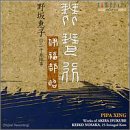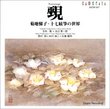| All Artists: Akira Ifukube Title: Ikufube: Pipa Xing Members Wishing: 1 Total Copies: 0 Label: Camerata Release Date: 3/28/2000 Genres: International Music, Special Interest, Classical Styles: Far East & Asia, Opera & Classical Vocal, Chamber Music, Historical Periods, Classical (c.1770-1830), Modern, 20th, & 21st Century Number of Discs: 1 SwapaCD Credits: 1 UPC: 034063055820 |
Search - Akira Ifukube :: Ikufube: Pipa Xing
 | Akira Ifukube Ikufube: Pipa Xing Genres: International Music, Special Interest, Classical
|
Larger Image |
CD DetailsSimilar CDs |
CD ReviewsAkira Ifukube & Keiko Nosaka at their best Rick | Japan | 09/05/2002 (5 out of 5 stars) "Unlike many koto CDs, this one doesn't make any misguided attempt to widen its audience by including various performers and works by various composers. The CD includes 3 works by Akira Ifukube ("Godzilla"). It is unique as far as I know in that all the pieces are solos for the 25-string koto and they're all played by Keiko Nosaka, the inventor and unrivalled master of the instrument. Thematically, the pieces are also linked, all being connected in some way with China or West Asia. This, in my opinion, makes them more accesible to many western listeners than pieces composed in the predominant "Japanese modern" tradition. Finally, two of the pieces are Ifukube's interpretation of what songs played on long-forgotten ancient instruments may have sounded like. This seems to free up his imagination as never before, and the music is strangely evocative, in places having a deceptively meandering character.
The first piece, Pipa Xing, is inspired by a poem by Bo Ju-Yi, from the Tang Dynasty, telling of the shared misfortune of the poet and a "pipa" (lute) performer, both of whom had been relegated from prominent positions in the imperial court. "The composition borrows some aspects of the form of the poem, and has a free three-part structure." (Quotes are from the liner notes.) It is particularly fitting to use the 25-string koto for such a subject because a 25-stringed zither, called the "se", used to be performed in ancient China. The second piece, Chant de la Serinde, is the shortest of the three and "is built up from an interplay between a slow, exotic melody in West-Asian style...and a section in rapid toccata style." The subject is the peoples who dwelled west of China in the days when the Silk Road was at its peak. The final piece is Kugo-Ka. The title refers to the "konghou", a harp-like instrument that was played in West Asia, China and Japan until around the 8th century, and was included at one time in the "gagaku" (Japanese court music) tradition. Interestingly, the piece was composed for the guitar in 1969, and the score was unmodified for performance on the koto. This must have presented many technical challenges for Nosaka, as traditional koto technique involves predominantly the thumb of the right hand, but she rises to them effortlessly. "The piece is in ternary form (ABA'), with a stately introduction. Section A is an allegretto dominated by elegant wave-like figures composed of groups of thirty seconds. B is an adagio in a broad, ancient lyrical style." If you have a vague knowledge of the traditional 13-string koto from "Melodies from Japan" style compilation CDs, often performed by former stars who have lost the power of their younger days, this CD may surprise you with its power, the range of the now 13-year-old 25-stringed version of the instrument, and the virtuosity of Nosaka, still the only prominent solo exponent of the instrument." |

 Track Listings (3) - Disc #1
Track Listings (3) - Disc #1